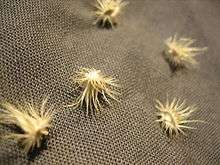Cenchrus biflorus
| Cenchrus biflorus | |
|---|---|
 | |
| Scientific classification | |
| Kingdom: | Plantae |
| (unranked): | Angiosperms |
| (unranked): | Monocots |
| (unranked): | Commelinids |
| Order: | Poales |
| Family: | Poaceae |
| Genus: | Cenchrus |
| Species: | C. biflorus |
| Binomial name | |
| Cenchrus biflorus Roxb. | |
| Synonyms | |
|
Cenchrus catharticus | |
Cenchrus biflorus is a species of annual grass in the Poaceae family. Common names include Indian sandbur, Bhurat or Bhurut in India, Haskaneet in Sudan, Aneeti in the Arabic dialect of Mauretania, K 'arangiya in the Hausa language of Nigeria, and Ngibbi in the Kanuri language of Nigeria.[1] In the francophone countries of the Sahel, it is usually referred to as "cram-cram".
It is common in the Sahel savannas of Africa, south of the Sahara.[2] According to a botanical criteria of geographer Robert Capot-Rey, the northern limit of Cenchrus biflorus defines the southern boundary of the Sahara.[3][4]
It is also found in India, where the seeds are used in Rajasthan and its Marwar region to make bread, either alone or mixed with bajra (millet).[1]
Uses
A traditional food plant in Africa, this little-known grain has potential to improve nutrition, boost food security, foster rural development and support sustainable landcare.[5]
References
- 1 2 "Famine foods: Poaceae or Gramineae" Purdue University Department of Horticulture and Landscape Architecture . Accessed December 29, 2007.
- ↑ "Sahelian Acacia savanna". Terrestrial Ecoregions. World Wildlife Fund. Retrieved December 29, 2007.
- ↑ Grove, A.T., nicole (2007) [1958]. "The Ancient Erg of Hausaland, and Similar Formations on the South Side of the Sahara". The Geographical Journal. Blackwell Publishing. 124 (4): 528–533. doi:10.2307/1790942. JSTOR 1790942.
- ↑ Bisson, J. (2003). Mythes et réalités d'un désert convoité: le Sahara (in French). L'Harmattan.
- ↑ National Research Council (1996-02-14). "Wild Grains". Lost Crops of Africa: Volume I: Grains. Lost Crops of Africa. 1. National Academies Press. p. 262. ISBN 978-0-309-04990-0. Retrieved 2008-07-18.